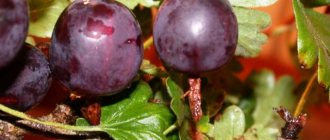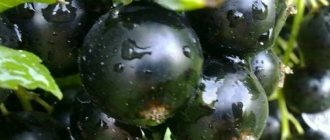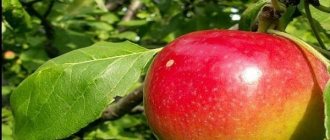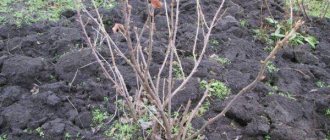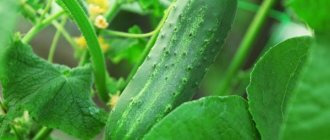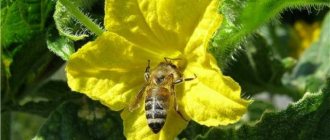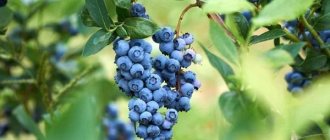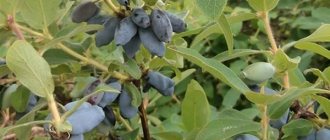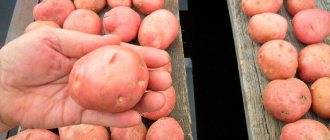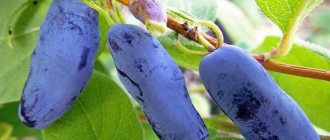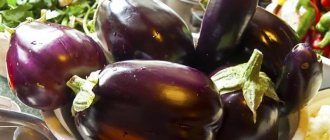Description of the variety
The Chernomor variety was bred in the late 1970s in Michurinsk at the All-Russian Scientific Research Institute of Horticulture named after. I.V. Michurin by crossing gooseberry varieties: 21-52, Date, Green bottle, Brazilian and Maurer's seedling. Included in the State Register of Breeding Achievements in 1994, zoned in the Central region, but successfully cultivated throughout Russia.
Chernomor belongs to the mid-late gooseberry varieties.
The berries in the fully ripe phase are dark red, almost black, hairless, covered with a thick waxy coating. The berries ripen in the first – second ten days of July. The average weight of the berry is 3.0 g, the shape is round-oval. The taste is high. The pulp is very sweet (sugar content 8-12%). Average yield is 3-4 kg. from a bush (10-13 t/ha). Fruit tasting score: 4.3 points.
The height of the berry bush is 1.0-1.2 m, the growth of shoots is enhanced, spreading is moderate, the diameter of the stems is average. The shoots are erect, some have drooping tips. The spines are sparse, thin, single. The leaves are dark green, three-five-lobed, shiny, with a straight base, of medium size.
Description and characteristics
Gooseberry of mid-late ripening period. Bushes of the Chernomor variety are vigorous, up to 1.5 meters high. They are not prone to spreading, have a dense bush, and the shoots are erect. They have a drooping top, a soft green tone, and no pubescence. There are very few thorns on the bushes, the spines are single, directed downwards. The buds are medium in size and have no hairs. The leaves are rich green, divided into 5 lobes. During the pollen phase, the Chernomor variety produces elongated, medium-sized flowers.
The fruits are of medium diameter, weighing up to 3 grams. When they are at the stage of technical ripeness, the color is burgundy, but after a while it turns black. The taste is pleasant, sweet and sour, with a pronounced aftertaste. The peel is medium in thickness, with minor veins. Sugar content of Chernomor berries varies between 8.5-12%, acidity – 1.7-2.5%.
Precociousness
The variety is fast-growing and begins to bear fruit early. After planting, a tree of the Chernomor variety bears fruit in 2-3 years.
Productivity
The Chernomor gooseberry variety is high-yielding; up to 4 kg of fruits are collected from 1 bush. The intensity of fruiting is affected by the availability of proper care and weather conditions. In the South, the harvest is more abundant than in the northern latitudes.
Self-fertility
The Chernomor variety is a self-pollinating variety, but to enhance fruiting, pollinators are planted nearby. They should be located at a distance of 3 meters from each other.
Immunity
Chernomor gooseberries have strong resistance to powdery mildew, but there is a risk of developing fungal infections. To avoid them, they resort to preventive treatments with protective agents; they prevent the spread of infection. As a preventive measure, pour boiling water over the holes. Then the soil is disinfected from most pathogenic agents.
Drought resistance
Gooseberry Chernomor can withstand short periods of drought. The crop is moisture-loving; in the absence of frequent watering, the harvest becomes smaller and the quality of the berries decreases.
Winter hardiness
Chernomor gooseberry bushes calmly survive frosts down to -35 degrees. During spring frosts, branches may freeze.
Transportability
Gooseberry fruits of the Chernomor variety can be transported over long distances, having previously been placed in the required containers. Since the skin is of medium density, the berries do not wrinkle and preserve their presentation.
Advantages and disadvantages of the variety
The Chernomor variety exhibits very high winter hardiness, is undemanding to soil, and drought-resistant. Even taking into account the strong growth of shoots, each plant is distinguished by its compact shape. Fruits with high taste, a small amount of seeds, are suitable for fresh consumption and all types of processing - for jam, preserves, compote, and freezing. The variety is resistant to powdery mildew and moth, is practically devoid of thorns, and has good survival rate when propagated by cuttings.
Disadvantages include the possibility of damage by aphids, moths, and sawflies. Ripe berries are exposed to the sun for a long time and baked. The bushes are prone to thickening and require annual pruning.
Cultivation care
The gooseberry variety Chernomor does not cause problems during the growing process; caring for it consists of performing basic agrotechnical practices, including organizing an irrigation system, removing weeds, fertilizing, protecting from pests and diseases.
Watering
During the dry season, gooseberry bushes should be moistened regularly, starting the procedure as the top layer of soil dries. It is necessary to pour water at the root, avoiding contact with the leaves of the crop. Otherwise, there is a high probability of developing diseases. The sprinkling method does not work in this case.
Excessive humidity in the bite circle is just as dangerous for the bush, as is its deficiency. A lack of moisture in the soil should not be allowed, especially in the spring at the stage of active plant growth and formation of ovaries. In the summer, the bushes experience an urgent need for water 2 weeks before the fruits reach their consumer maturity.
Fertilizers
In late April and early May, the soil under the bushes should be loosened to a depth of 6-8 centimeters, leveled and mulched with peat and humus at the rate of 10 kilograms per garden planting. And in the fall, dig up the organic matter with a pitchfork. In the first 3 years, it is prohibited to use phosphorus and potassium compounds to feed gooseberries, since these substances were placed in the hole when the seedlings were planted. In the spring, you need to add urea in several stages: 15 grams - in early May, 10 grams - at the end of the flowering phase.
In the fourth year after planting the Chernomor gooseberry in a permanent place, a mixture of superphosphate (150 grams), potassium sulfate (40 grams), wood ash (200 grams) and organic matter (8-10 kilograms) should be added to the soil. This feeding is done every 3-4 years.
Gooseberry formation
The next year after planting, 4-5 of the strongest shoots are left on the bush, and the excess ones are completely removed. In the future, also choose 5 shoots that are well located. Branches aged 4-6 years are considered productive; specimens older than 7 years are cut out. Formative pruning is carried out in the fall or before buds open.
Landing
Chernomor gooseberries are planted in sunny places protected from the winds. The soils chosen are light and permeable. If there is a lot of clay on the site, river sand and garden soil are added to the planting holes in a ratio of 1:2.
Regardless of the type of soil, phosphorus-potassium fertilizers are added to each hole: superphosphate 20-30 g and potassium sulfate. 30-40 g. The pits are prepared in advance so that the soil has time to settle (for spring planting - from autumn). The planting itself is carried out in autumn or spring. The timing of spring planting is very short - you need to manage to meet the interval between the snow melting and the beginning of sap flow. In the fall, there will be more time for planting seedlings; the main thing is to complete the activity 3-4 weeks before the first frost.
The size of the planting pit is 40x40x40 cm. The distance between pits in a row is 1.0-1.2 m, row spacing is at least 2.0 m.
Chernomor gooseberry seedlings are pruned before planting: the roots (tips and rotten/dried areas) and branches are shortened (5-6 buds should remain on each). Then the root system of the seedling is kept in Kornevin’s solution (at least 3 hours), after which it is dipped into a mash of clay and mullein, and planted in a hole, deepening the growth point by 5-7 cm. The soil in the hole is compacted so that there are no air cavities left. , each seedling is watered with 12-15 liters. water.
After planting, the holes are mulched with straw, sawdust or mown grass, the spaces between the bushes are weeded and kept clean, since weeds increase humidity and can provoke the development of powdery mildew.
Agricultural technology varieties
Due to the fact that gooseberry roots are located much deeper than other shrubs, the crop is considered drought-resistant. In addition, it tolerates shading well. What Chernomor does not like is high humidity - it cannot be planted in lowlands, otherwise there is a high probability of developing fungal diseases. When choosing a place for this gooseberry, it is better to give preference to areas where there is enough sunlight and protection from the cold north wind.
Like many fruit shrubs, Chernomor gooseberries can be planted both in autumn and spring, but autumn planting is considered more preferable: in this case, the seedling has time to take root before the onset of cold weather. Don't forget that the bush is equipped with thorns, so try to keep the area around the bush cleared to make weeding easier. Immediately before planting, remove all damaged or dried roots from the seedling, trim the above-ground part of the plant, shortening the branches by about one third.
Caring for the bushes will consist of regular pruning (in autumn or spring), removing weeds, regular feeding and preventing the development of diseases. For fertilizer, nitrogen and potassium mixtures are used, or organic compounds - a diluted infusion of manure, which is used to water the ground around the bushes.
If dry weather sets in, do not forget to water the gooseberry bushes. This should be done at the root of the plant to minimize the risk of developing fungal infections. Under no circumstances should watering by sprinkling or using cold water be allowed for irrigation.
To increase productivity, some gardeners resort to summer pruning: they remove young soft shoots that are not valuable for normal development. This technique allows you to increase the size of each berry.
Growing and care
Activities for caring for Chernomor gooseberries consist of watering, weeding, fertilizing, pruning the bush and treating it against diseases and pests.
Watering
The first watering is given before flowering. The second and subsequent ones - after the formation of the ovary and before the start of ripening. During fruit ripening, watering is stopped, otherwise the required amount of sugars will not accumulate in the berries. After harvesting, give one or two more waterings until the end of summer. At the end of October, moisture-charging irrigation is required at the rate of 30-40 liters. water per 1 m2.
Trimming
Formative pruning of the Chernomor variety begins in the second year of cultivation. Leave 3-4 skeletal branches, which should be directed in opposite directions from each other. Branches of the second and third order are thinned out annually in spring or autumn. After pruning, the bush should be well ventilated and convenient for harvesting.
Top dressing
At the beginning of the growing season (mid-May), gooseberries are fed with complex mineral fertilizer - Azofoska, 20 g per bush. Before ripening, fertilize with phosphorus-potassium fertilizers. Once every 2-3 years in the fall, fertilize with well-rotted manure or compost. In August, it is permissible to fertilize with potassium chloride 16-20 g per bush. Before wintering, the soil between the rows is weeded and dug to a depth of 12-18 cm.
Protection from diseases and pests
To protect plants from moth caterpillars, 3-4 sprayings are carried out during the growing season with Fufanon, Cyperus or Samurai. Thiovit Jet, Topaz, and Titan are effective for combating American powdery mildew. In gardens where other berries, such as currants, strawberries and raspberries, are ripening nearby, they are sprayed with biological products Alirin B, Gamair, Fitosporin-M.
Description and characteristics of the gooseberry variety Chernomor, planting and care
The self-pollinating Chernomor gooseberry, similar in appearance to a date, confidently holds its position in the market; the berry is also called northern grapes. He was bred at the All-Russian Research Institute named after I.V. Michurin.
Biological material was taken from the Date, Brazilian, Green Bottle, and Seedling Maurera varieties.
Growing Chernomor gooseberries is not particularly difficult; the main thing is to know its strengths and weaknesses, the basic rules of planting and care.
Planting seedlings
It is recommended to treat the selected planting material with a growth stimulator. Its roots are immersed in the working solution for 10-15 minutes. The technology for planting Chernomor gooseberries involves performing the following actions:
- It is better to pour a layer of fertile soil into the hole in the form of a mound.
- Place the prepared seedling in the center of the hole.
- Straighten its roots and gently sprinkle with soil, slightly compacting it.
- Water thoroughly and mulch the soil around the tree trunk with peat and rotted sawdust. Just dry soil will do.
- After 3-4 days, irrigation and mulching are repeated again.
You should not deepen the root collar of the Chernomor gooseberry too much; it is enough to determine it to a depth of 3-5 centimeters.
Cultivation care
The gooseberry variety Chernomor does not cause problems during the growing process; caring for it consists of performing basic agrotechnical practices, including organizing an irrigation system, removing weeds, fertilizing, protecting from pests and diseases.
Watering
During the dry season, gooseberry bushes should be moistened regularly, starting the procedure as the top layer of soil dries. It is necessary to pour water at the root, avoiding contact with the leaves of the crop. Otherwise, there is a high probability of developing diseases. The sprinkling method does not work in this case.
Excessive humidity in the bite circle is just as dangerous for the bush, as is its deficiency. A lack of moisture in the soil should not be allowed, especially in the spring at the stage of active plant growth and formation of ovaries. In the summer, the bushes experience an urgent need for water 2 weeks before the fruits reach their consumer maturity.
Fertilizers
In late April and early May, the soil under the bushes should be loosened to a depth of 6-8 centimeters, leveled and mulched with peat and humus at the rate of 10 kilograms per garden planting. And in the fall, dig up the organic matter with a pitchfork.
In the first 3 years, it is prohibited to use phosphorus and potassium compounds to feed gooseberries, since these substances were placed in the hole when the seedlings were planted.
In the fourth year after planting the Chernomor gooseberry in a permanent place, a mixture of superphosphate (150 grams), potassium sulfate (40 grams), wood ash (200 grams) and organic matter (8-10 kilograms) should be added to the soil. This feeding is done every 3-4 years.
Gooseberry formation
The next year after planting, 4-5 of the strongest shoots are left on the bush, and the excess ones are completely removed. In the future, also choose 5 shoots that are well located. Branches aged 4-6 years are considered productive; specimens older than 7 years are cut out. Formative pruning is carried out in the fall or before buds open.
Disease and pest control
Gooseberries of the Chernomor variety are characterized by increased immunity to major ailments. But for the purpose of prevention, it should be treated in the spring with a working solution based on Karbofos or ash infusion. If necessary, the manipulation is repeated again.
Breeding the variety
The variety reproduces well through horizontal layering. For these purposes, it is necessary to loosen the soil under the plant and enrich it with organic matter. Bend long and powerful shoots to the ground and secure with hooks. When vertical shoots 10 centimeters long grow, they need to be spudded and watered twice. In the fall, they are separated from the mother bush and planted.
Collection and storage of berries
If the crop is to be transported over long distances, it is recommended to remove the fruits 2 days before they reach consumer maturity. If the berries are used fresh, they are harvested when they are fully ripe. Dry unripe fruits can be stored in a cool room for 3-4 days, and ripened ones - 2 days.
Black Sea gooseberry is a highly productive and unpretentious plant. If you follow all the recommendations regarding its planting and care, you can reap the maximum possible harvest.
Reproduction
To propagate gooseberries of the Chernomor variety, two methods of vegetative propagation are used:
- dig in branches at the beginning of summer;
- cuttings are planted in August.
Cuttings allow you to get more plants in one planting, but the percentage of plant survival with this method is much lower, although if we consider the Chernomor variety, then one of its advantages is the good survival rate of green cuttings. Cuttings 12-15 cm long are cut from healthy, powerful two-year-old shoots and planted in a substrate prepared from equal parts of sand, peat and garden soil. Before planting, they are treated with root formation stimulants and only then immersed 1/3 of the length (about 5-6 cm) into the soil.
If branch digging is used, a healthy branch is placed in a shallow groove, pinned with wire and covered with soil so that only the tip sticks out. The soil is kept moist. After some time, roots will appear on the stem and in the second half of September, ready-rooted plants can be separated from the mother bush and replanted in a permanent place.
Gooseberry Sirius: propagation options
Most often, Sirius gooseberries are not propagated by seeds, since with such planting the bush will not retain the main characteristics of the variety. This option will be expensive, but will not pay for the required plant criteria.
Effective propagation options:
- Dividing shrubs 5 years old and above;
- Taps. Strong 2-year-old shoots or first-year growths are taken. To begin with, the soil is dug up and fed with fertilizers. Small trenches are made, and shoots are taken from the main bush. It is necessary to tilt the branches to the ground, place them in trenches and secure them. The shoots are sprinkled with soil, irrigated with water and the tops are pinched. In summer, the branches are constantly watered, but the ground under the bush should not be very damp. New shoots are fertilized with humus and moistened soil. In autumn, the cuttings are transported to another place, separating the shoots from the main bush. Young layerings are covered in winter.
- Green and woody cuttings. In order for the cuttings to quickly adapt, the seedlings need to be treated with Kornevin or Heteroauxin. Green cuttings take root best, which many gardeners have already been able to test.
Reviews
I have been growing gooseberries for a long time. There are currently 7 varieties of it in my garden. "Chernomor" is one of the best. Of course, if you evaluate only the taste and size of the fruit, then there are much more interesting varieties. But if we also take into account resistance to powdery mildew, drought resistance, compactness, then according to these indicators “Chernomor” is the winner.
I really like the taste of Chernomor - so pleasant with notes of wine. The color of the berry is very interesting - black, like a currant. Now my bushes are growing in a standard form, but I want to transfer them to a regular bush form. In the sun, Chernomor berries bake and lose their taste. What I also like about the variety is the excellent survival rate of cuttings. I propagate the rest of the varieties only by layering; I don’t want to bother with cuttings, but in the case of Chernomor, on the contrary, I don’t want to bother with digging.
Advantages of the variety
The main advantage of the Chernomor gooseberry is its high yield.
From one bush you can collect at least four kilograms of delicious berries. An undoubted advantage over other varieties is excellent winter hardiness. Gooseberry Chernomor tolerates severe frosts very well, which very often happen in our country. In addition to resistance to frost, this variety is also famous for its persistent tolerance to prolonged drought. That is, in general, this variety is incredibly unpretentious and hardy. A pleasant advantage of this variety is the rather small number of seeds in the berries.
How to plant
It is necessary to plant Chernomor gooseberries at the right time, choosing the right soil. The landing process is standard and does not involve any special features.
Selecting a location
Gooseberry Chernomor prefers places well lit by the sun, not blown by northern winds. You should not place seedlings near tall buildings; the shoots should receive the required amount of sunlight. You cannot plant seedlings in lowlands, as moisture often accumulates there. It is optimal to place the crop on level ground or hills, on the south side of the garden.
Deadlines
Gooseberries of the Chernomor variety are optimally planted in autumn or spring. Autumn planting is more preferable, then the seedlings have time to take root before the arrival of cold weather. It is important that there is 1 month left before frost.
Soil requirements
Gooseberry Chernomor prefers to grow on loamy, sandy loam soils or black soil. It cannot be planted on swampy, heavily podzolic lands, heavy loams, or sands. The acidity of the soil should be pH 6-6.5, a neutral level. The normalized rate of groundwater flow is 1.5 meters.
See also
Description of gooseberry variety Beryl, features of planting and care
Read
How to prepare the soil
Before planting, 2 weeks in advance, plow the soil with a spade and remove weeds. Compost, rotted manure 10 kg per 1 garden planting, 100 g of wood ash, 50 g of superphosphate, 40 g of potassium sulfide are added to the ground. The holes should have a diameter of 30*40*40. Maintain a distance of 1.5 meters between bushes and 2 meters between rows.
Purchase and preparation of seedlings
When choosing seedling material, it is worth carefully inspecting it for flaws, putrefactive processes or traces of disease. It is advisable to take two-year-old seedlings with an open rhizome, or in a pot. Then they focus on the length of the branches with foliage - 40-50 cm, the white tint of the roots, there are a large number of them.
After purchasing seedlings of the Chernomor variety, shorten the tips of the root system and shoots, leaving 5-6 buds. Gooseberries are dipped in a growth stimulator for 2 hours; you should give preference to Matador or Epin. In order to disinfect the seedlings, keep them for 30 minutes in a weak manganese solution.
Planting scheme
Chernomor gooseberries should be planted according to the scheme below.
- Fill the holes with fertile soil and make a mound out of it.
- Place gooseberry seedlings into the holes.
- Spread the rhizomes, sprinkle them with soil, compact them a little.
- Water, mulch with sawdust and peat.
- After 3 days, repeat the irrigation and mulching procedure.
Deepen the root collar to a maximum of 5 cm.
Breeding the variety
The variety reproduces well through horizontal layering. For these purposes, it is necessary to loosen the soil under the plant and enrich it with organic matter. Bend long and powerful shoots to the ground and secure with hooks. When vertical shoots 10 centimeters long grow, they need to be spudded and watered twice. In the fall, they are separated from the mother bush and planted.
Description
The plant is a vigorous plant, its height reaches 1.5 meters. At the same time, the gooseberry bush is not too spreading, as if compressed, with a thick crown. The number of root shoots is average. The branches of Chernomor are directed vertically upward, the degree of branching is moderate. The growing shoots are medium-sized, straight, sometimes with a hanging tip, the bark is pubescent, light green in color with anthocyanin coloring in the upper part. Lignified shoots are medium-sized, light-colored. Shoots with weak thorniness. The spines are usually single, sparse, short or medium in length, straight or slightly curved, thin, dark-colored, matte, growing downward, localized in the lower part of the shoot. There are no spines. The buds of the variety are small, hairless, oblong in shape with a pointed apex, light-colored, and grow deviating from the shoot. A trace from a fallen leaf is round in shape.
The leaves of Chernomor are small in size, medium density, dark green in color, the surface is convex, pubescent, shiny, smooth or folded. The main veins are not colored. The shape of the gooseberry leaf blade is three- or five-lobed, the cuts between the blades are deep. The central lobe rises above the lateral ones, its apex is pointed, and the lateral edges are cut off towards the base. The length of the lateral lobes is average, they have a rounded shape, the angle of connection between the veins is sharp. The basal lobes are poorly developed, their veins are spread out. The leaf has a straight base, sometimes with a shallow notch. The angle between the petiole and the base of the blade is most often straight. The petiole is of normal length and thickness, the lower part is covered with sparse glandular pubescence, and is located at an angle of 30 °C to the shoot. The inflorescence of the variety consists of 2 - 3 medium-sized flowers. The corolla is elongated, brightly colored. The sepals are free, bent upward, somewhat elongated, brightly colored. The ovary is anthocyanin colored and covered with slight pubescence.
Chernomor berries are small, the weight described by the State Register is about 3.0 grams (during the years of research from 1980 to 1984, the weight of the berries was 4.8 grams), oval or round-oval in shape. The calyx is long and large, full, closed. The skin is not too thick, but quite durable, with barely noticeable pubescence or without pubescence, a waxy coating is present. Not quite ripe gooseberry fruits are dark red. When fully ripe they become almost black. The venation is weak, the slightly branched veins are lighter than the main color, and when fully ripe they become almost invisible. The taste is harmonious, sweet and sour, but with a predominance of sweetness. Taster rating: 4.3 points. The correlation between fruit weight and number of seeds is 0.74. The number of seeds per unit mass of berry is small - 2.6 ± 0.2. 100 grams of raw product contains: total sugars 8.4 - 12.2%, titratable acids 1.7 - 2.5%; pectin 5.6 - 6.8%; ascorbic acid 29.3%. The peduncle is long and thin, with a light anthocyanin color at the base.
Gooseberry Chernomor: reviews from gardeners
Gooseberry Chernomor: photo of the variety
Gardeners who have been growing Chernomor gooseberries for many years have identified it for themselves as the number one variety.
The bush produces a stable harvest of sweet and tasty berries. Some gardeners point to their pleasant wine-like aroma. According to others, the taste of the berries is characteristic of gooseberries and nothing more, however, they note that in terms of the variety’s resistance to weather conditions and disease, Chernomor is one of the best.
And, of course, on the positive side, they note the weak thorniness of the bush, which makes harvesting easier. But it is not recommended to delay picking berries, since overripe berries lose their taste.
Harvest and storage
Chernomor gooseberries for processing are harvested 2 weeks before consumer maturity, when the fruits are still green, hard, and have reached the desired size. To eat them fresh, the berries are picked completely ripe. Then they acquire sweetness, a characteristic dark burgundy hue.
The harvest harvested at the technical ripeness stage is stored for 2 weeks in a cool place like a refrigerator or cellar. Before being sent for storage, the fruits are sorted and damaged and rotten ones are discarded.
Harvested Chernomor gooseberries at the stage of full ripeness are stored in baskets for up to 1 week. Harvest in dry weather.
Reviews from summer residents
Gardeners speak positively about Chernomor.
Maria, Tula: “ In my opinion, this is the best variety of gooseberry. It has been growing on the site for many years, it bears fruit consistently, the harvest is large, and the bushes have never gotten sick. Of course, I carry out preventive treatments, but I think it’s not only this, but also the high immunity of the plant.”
Irina, Moscow region: “Gooseberries are my favorite berry. I used to buy it all the time, and when the plot became available, I planted several bushes. On the advice of friends, I chose Chernomor and I don’t regret it. The berries are very tasty, aromatic, they are a pleasure to eat fresh, and the jam turns out excellent. The seedlings took root quickly and began bearing fruit the very next year. The bushes do not get sick and are resistant to cold and drought.”
Valery, Bryansk: “Chernomor is definitely one of my top five favorite gooseberry varieties. Apart from the rather small berries, I don’t see any shortcomings in it. The bushes are compact, and with proper and regular pruning they become a real decoration of the site. They don’t get sick, pests don’t attack them, they bear fruit well, and the yield is high every time.”
Agrotechnical features
When caring for gooseberries of the Kuibyshevsky variety, the main activity is regular pruning. If this agrotechnical measure is ignored, the bush will quickly become thickened and the yield will decrease. Pruning is carried out in the fall, preparing the gooseberries for winter. Branches that are more than five years old are mercilessly disposed of. The branches that grow inside the bush are also cut out.
Gooseberries are quite drought-resistant, but during flowering and fruiting, in dry, hot weather, watering is necessary. They are carried out at intervals of 10 days and stopped several weeks before harvest, so that the fruits are sweeter and not watery.
Gardeners are divided on resistance to powdery mildew. There are reviews that talk about absolute immunity. The description of the variety indicates average resistance to fungal diseases.
To be on the safe side, after the autumn sanitary pruning, you should spray the bush with 1% Bordeaux mixture. Additionally, this will prevent overwintering of insect pest larvae on the branches.
The variety is winter-hardy. However, if the winter has little snow and frost, it would not be a bad idea to cover the bush with agrofibre.
